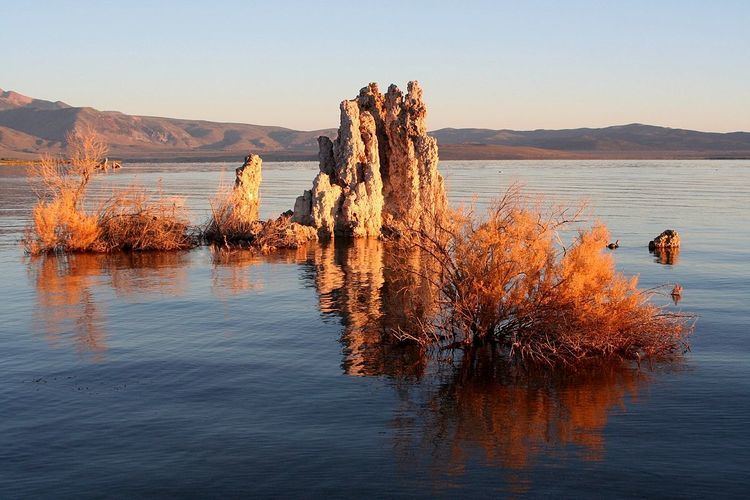 | ||
Tufa is a variety of limestone formed when carbonate minerals precipitate out of ambient temperature water. Geothermally heated hot springs sometimes produce similar (but less porous) carbonate deposits known as travertine. Tufa is sometimes referred to as (meteogene) travertine (Allen Pentcost). It should not be confused with hot spring (thermogene) travertine. However, Mono Lake's tufa is thermogene, according to Pentecost. Tufa, which is calcareous, should not be confused with tuff, a porous volcanic rock with a similar etymology that is sometimes also called "tufa".
Contents
Classification and features
Modern and fossil tufa deposits abound with wetland plants; as such many tufa deposits are characterised by their large macrobiological component and are highly porous. Tufa forms either in fluvial channels or in lacustrine settings. Ford and Pedley (1996) provide a review of tufa systems worldwide.
Fluvial deposits
Deposits can be classified by their depositional environment (or otherwise by vegetation or petrographically). Pedley (1990) provides an extensive classification system, which includes the following classes of fluvial tufa:
Lacustrine deposits
Lacustrine tufas are generally formed at the periphery of lakes and build up phytoherms (freshwater reefs) and stromatolites. Oncoids are also common in these environments.
Other deposits
While fluvial and lacustrine systems make up the bulk of tufa systems worldwide, there are several other important tufa environments.
Calcareous sinter
Although sometimes regarded as a distinct carbonate deposit, calcareous sinter formed from ambient temperature water can be considered a sub-type of tufa.
Speleothems
Calcareous speleothems may be regarded as a form of calcareous sinter. They lack any significant macrophyte component due to the absence of light, and for this reason they are often morphologically closer to travertine or calcareous sinter.
Tufa columns
Tufa columns are an unusual form of tufa typically associated with saline lakes. They are distinct from most tufa deposits in that they lack any significant macrophyte component; this is due to the salinity excluding mesophilic organisms. Some tufa columns may actually form from hot-springs and therefore actually be a form of travertine. It is generally thought that such features form from CaCO3 precipitated when carbonate rich source waters emerge into alkaline soda lakes. They have also been found in marine settings.
Biology
Tufa deposits form an important habitat for a diverse flora. Bryophytes (non-vascular land plants) and diatoms are well represented. The porosity of the deposits creates a wet habitat ideal for these plants.
Geochemistry
Modern tufa is formed from alkaline waters, supersaturated with calcite. On emergence, waters degas CO2 due to the lower atmospheric pCO2 (see partial pressure), resulting in an increase in pH. Since carbonate solubility decreases with increased pH, precipitation is induced. Supersaturation may be enhanced by factors leading to a reduction in pCO2, for example increased air-water interactions at waterfalls may be important, as may photosynthesis.
Recently it has been demonstrated that microbially induced precipitation may be more important than physico-chemical precipitation. Pedley et al. (2009) showed with flume experiments that precipitation does not occur unless a biofilm is present, despite supersaturation.
Calcite is the dominant mineral precipitate found; however, the polymorph aragonite is also found.
Occurrence
Tufa is common in many parts of the world. Some notable deposits include:
Some sources suggest that "tufa" was used as the primary building material for most of the châteaux of the Loire Valley, France. This results from a mis-translation of the terms "tuffeau jaune" and "tuffeau blanc", which are porous varieties of the Late Cretaceous marine limestone known as chalk.
Uses
Tufa is today occasionally shaped into a planter. Its porous consistency makes tufa ideal for alpine gardens. A concrete mixture called hypertufa is used for similar purposes.
